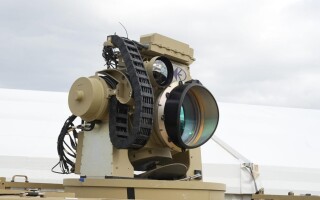Advanced Navigation announces Boreas D70
Press ReleaseOctober 24, 2022

Advanced Navigation, the world’s most determined innovator in artificial intelligence for robotic and navigation technologies is announcing Boreas D70, a fiber-optic gyroscope (FOG) inertial navigation system (INS).
The D70 is the latest release in the Boreas digital FOG (DFOG) series, offering a new performance grade with superior accuracy, exceptional stability and reliability. The technology is well suited to surveying, mapping, and navigation across subsea, marine, land and air applications.
“We are thrilled to expand the Boreas series with the D70. It's a system that will provide additional flexibility in the Boreas family, making ultra-high accuracy inertial navigation far more affordable than previous FOG INS systems,” said Xavier Orr, CEO and co-founder of Advanced Navigation.
“This patented technology opens the possibility for adopting FOG INS systems across a much broader range of vehicular applications, particularly autonomous vehicles and aircraft, where weight and size are at a premium.”
D70 UNRIVALLED PERFORMANCE
Boreas D70 combines cutting-edge closed-loop DFOG and accelerometer technologies, with a dual antenna RTK GNSS receiver. These are coupled with Advanced Navigation’s AI based fusion algorithm to deliver accurate and precise navigation.
The system features ultra-fast gyro compassing, acquiring and maintaining an accurate heading under the most demanding conditions. While D70 does contain a GNSS receiver, it’s not required for gyrocompass operation.
Based on revolutionary DFOG technology, D70 delivers a 40% reduction in size, weight, power and cost (SWaP-C), when compared to systems of similar performance:
- 0.01° roll and pitch
- 0.1° secant latitude heading (gyrocompass)
- 0.01° /hour bias instability
- 10mm position accuracy
THE BOREAS SERIES
The Boreas DFOG series features ultra-fast gyro compassing and can acquire heading, either stationary or dynamically, in under 2 minutes. The gyro compassing allows the system to determine a highly accurate heading without any reliance on magnetic heading or GNSS.
The technology stems from Advanced Navigation’s revolutionary AI sensor fusion algorithm allowing the system to extract significantly more information from the data. It is designed for control applications, with a high level of health monitoring and instability prevention to ensure stable and reliable data.
Advanced Navigation designed Boreas from the ground up for reliability and availability. The hardware and software are designed and tested to international safety standards and have been environmentally tested to MIL-STD-810. The system achieves a mean time between failure (MTBF) of over 70,000 hours.
Additional features of the Boreas D70 include Ethernet, CAN and NMEA protocols, as well as disciplined timing via a PTP server and 1PPS. A rich, responsive embedded web interface provides full access to all of the device’s internal functions and data. Internal storage allows for up to 1 year of data logging.
ABOUT DFOG TECHNOLOGY
DFOG is patented technology, which has been developed over 25 years involving two research institutions. DFOG was created to meet the demand for smaller and more cost-effective FOGs, while increasing reliability and accuracy.
The first generation of FOG made available in 1976 used analog signals and analog signal processing. The second generation was developed in 1994 and is still used to this day. It improved upon the first generation with a hybrid approach using an analog signal in the coil with digital signal processing.
In 2021, FOG has evolved into DFOG. This third generation of FOG sets itself apart by being completely digital, providing higher performance and reliability while enabling a 40% reduction in size, weight, power, and cost (SWaP-C).
To achieve this, three different, yet complementary, technologies have been developed to improve the capabilities of FOG.
1. Digital Modulation Techniques: DFOG uses a specially developed digital modulation technique passing spread spectrum signals through the coil. The new digital modulation technique introduced in DFOG technology allows in-run variable errors in the coil to be measured and removed from the measurements. This makes DFOG significantly more stable and reliable than traditional FOGs. It also allows a smaller FOG with less coil length to achieve the accuracy of one with a longer coil.
2. Revolutionary Optical Chip: By integrating five sensitive components into a single chip and removing all the fiber splices, the size, weight, and power are reduced considerably while significantly improving reliability and performance.
3. Specially Designed Optical Coil: DFOG employs a specially designed closed-loop optical coil, developed to take full advantage of the digital modulation techniques. The design allows for optimum sensing of in-run variable coil errors using the new digital modulation technique. It also provides a very high level of protection for the optical components from shock and vibration.
Distinguished Professor Arnan Mitchell, the Director of the Integrated Photonics and Applications Centre at RMIT University, was a key partner in developing DFOG technology with Advanced Navigation. Professor Mitchell is a noted authority on microtechnology and nanotechnology whose work on shrinking components of a fiber optic gyroscope onto a single chip proved to be one of the key components of DFOG’s revolutionary technology. This innovation is what allows DFOG to have a significantly lower SWaP-C than other similar FOGs, all the while delivering higher accuracy and reliability.
Professor Mitchell explains, “By printing optical components onto a tiny chip, we are creating more compact and reliable fiber optic gyroscopes with Advanced Navigation.”




